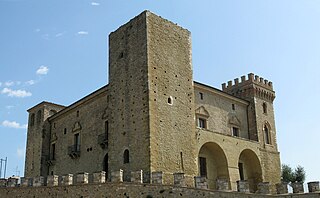
L'Aquila is a city and comune in central Italy. It is the capital city of both the Abruzzo region and of the Province of L'Aquila. As of 2023, it has a population of 69,558 inhabitants. Laid out within medieval walls on a hill in the wide valley of the Aterno river, it is surrounded by the Apennine Mountains, with the Gran Sasso d'Italia to the north-east.

The province of L'Aquila is the largest, most mountainous and least densely populated province of the Abruzzo region of Central Italy. It comprises about half the landmass of Abruzzo and occupies the western part of the region. It has borders with the provinces of Teramo to the north, Pescara and Chieti to the east, Isernia to the south and Frosinone, Rome and Rieti to the west. Its capital is the city of L'Aquila.

The province of Chieti is a province in the Abruzzo region of Italy. Its provincial capital is the city Chieti, which has a population of 50,770 inhabitants. The province has a total population of 387,649 inhabitants as of 2017 and spans an area of 2,599.58 square kilometres (1,003.70 sq mi). It is divided into 104 comuni (comune) and the provincial president is Mario Pupillo.

The province of Pescara is a province in the Abruzzo region of Italy. Its provincial capital is the city Pescara, which has a population of 119,483 inhabitants. As of 2017, it has a total population of 319,936 inhabitants over an area of 1,230.33 square kilometres (475.03 sq mi). The provincial president is Antonio Zaffiri and the province contains 46 comuni.

Alvito is a town and comune in central Italy, in the province of Frosinone, south of Rome in the Lazio region. Its territory is included in the Abruzzo, Lazio and Molise National Park.

The Duchy of Sora was a semi-independent state in Italy, created in 1443 by King Alfonso I of Naples and dissolved in 1796. It occupied the south-eastern part of what is today Lazio, bordering what is now Abruzzo. Its capital was first Sora, and later, under the Boncompagni family, Isola di Sora.

Pacentro is a comune of 1,279 inhabitants of the province of L'Aquila in Abruzzo, Italy. It is a well-preserved historic medieval village located in central Italy, several kilometers from the City of Sulmona about 170 kilometres (110 mi) east of Rome. It is a member of the I Borghi più belli d'Italia association.

Bugnara is a comune and village in the province of L'Aquila in the Abruzzo region of southern Italy. It is a member of the I Borghi più belli d'Italia association.

Popoli Terme is a comune and town in the province of Pescara in the Abruzzo region of Italy.

The Doge's Palace is a historical building in Genoa, northern Italy.

The Duchy of Alvito was a fiefdom of the Kingdom of Naples, in southern Italy.

Tourism in Abruzzo has become one of the most prosperous sectors in the economy of Abruzzo, and in recent years has seen a remarkable growth attracting numerous tourists from Italy and Europe. According to statistics, in 2021 arrivals totaled 1,330,887. A total of 5,197,765 arrivals were tourists, a figure that puts the region seventeenth among the Italian regions for numbers of tourists per year. A moderate support to tourism is also given to the Abruzzo Airport with many low cost and charter flights connecting the entire region with the rest of Europe.

The Abbey of the Holy Spirit at Morrone, known by various titles, is a former monastery some five kilometers outside of the town of Sulmona, at the base of Monte Morrone, in the Province of L'Aquila, region of Abruzzo, Italy.

Castello Cantelmo-Caldora is a Middle Ages castle in Pacentro, Province of L'Aquila (Abruzzo).
The Basilica of San Bernardino is a religious building located in L'Aquila, Italy. The church was built, with the adjacent cloister, between 1454 and 1472 in honor of St Bernardino of Siena. The facade was built by Silvestro dall'Aquila and later passed to Cola dell'Amatrice, reaching completion in 1542. It is a notable example of 16th century architecture combining Greek, Latin and Christian influences, divided into three orders, consisting of Doric, Ionic and Corinthian styles. The corpse of the saint is guarded inside the church in a mausoleum built by Silvestro dell'Aquila.

Castello Cantelmo is a Middle Ages castle in Pettorano sul Gizio, province of L'Aquila, Abruzzo, southern-central Italy.

Castello ducale Cantelmo is a Middle Ages castle in Popoli Terme, Province of Pescara (Abruzzo).

Castello ducale di Crecchio is a Middle Ages castle in Crecchio, Province of Chieti (Abruzzo).

The Ducal Palace or Palazzo Ducale of Atina is a 14th-century gothic-style, government palace in Piazza Saturno, in the center of the town of Atina, province of Rieti, region of Lazio, Italy.
Don Carlo II di Tocco Cantelmo Stuart, or Carlo di Tocco for short, was an 18th/19th-century Italian noble, serving as the Prince of Montemiletto and the titular Prince of Achaea, among other titles, from the death of his father Restaino di Tocco Cantelmo Stuart in 1796 to his own death in 1823. In addition to holding various fiefs throughout Italy, Carlo also rose to prominent positions within the Kingdom of Naples and its successor state, the Kingdom of the Two Sicilies. In 1808, he came one of the earliest knights of the Royal Order of the Two-Sicilies and from 1821 to 1823, he served as a Councellor of State in the Kingdom of the Two Sicilies.



















